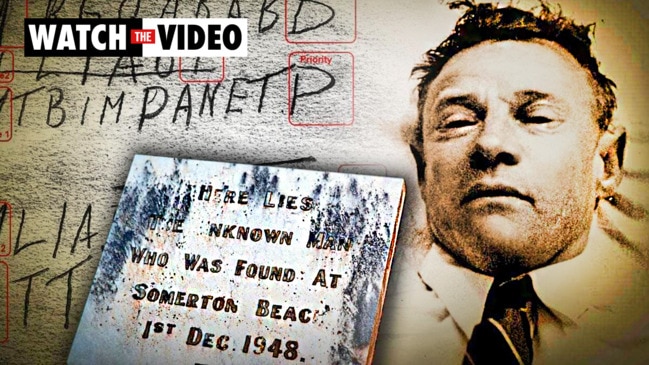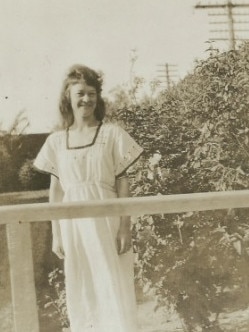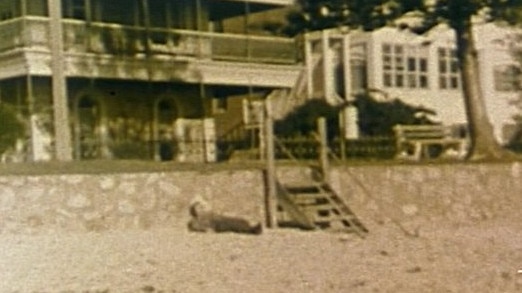New details emerge about the Somerton Man – Carl “Charles” Webb: Family photos, new details
New details have emerged of the Somerton Man, including family photos, as we reveal everything we know about Carl Webb – and the questions we’re still pondering.

SA News
Don't miss out on the headlines from SA News. Followed categories will be added to My News.
The first picture of the Somerton Man’s sister has emerged as new information reveals why he may have been wearing clothing from the United States at the time of his death.
The Advertiser has obtained pictures of Doris Maud Webb, who was born four years before him in 1901.
The information comes weeks after Adelaide University engineer and case expert Derek Abbott, with US genealogy expert Dr Colleen Fitzpatrick, identified the mystery man using DNA techniques.
They believe Carl “Charles” Webb is the Somerton Man, revealing the discovery 74 years after his body was found slumped against a seawall at Somerton Beach.
Prof Abbott has undertaken extensive research since the mystery was solved last month through newspaper clippings, and speaking to distant relatives leading him to more information on Mr Webb’s family.


He was the youngest of six siblings – four of whom were still alive at the time of Mr Webb’s death.
Prof Abbott said a son of Richard Russell Webb – the Somerton Man’s oldest brother who was born in 1893 – provided information regarding the family’s heritage.
“I took the important bits of information out from there about their occupations and stuff like that,” Prof Abbott said.
“Some have come from the war records and other articles, so I’ve sort of put it all together to paint a bit of a picture.”
The new information has uncovered Mr Webb had German ties, as his father, Richard August Webb was a migrant from Hamburg in Germany before moving to Australia.
After marrying Eliza Amelia Morris Grace in 1892, the couple opened a bakery in Springvale, Victoria, about 20km out of central Melbourne.
Prof Abbott said Mr Webb, with his brothers Roy and Richard, all initially worked in the family bakery.
Mr Webb’s eldest sister Freda Grace Webb married Thomas Gerald Keane, which explained why some of his property was labelled Keane including on the back of his tie.
The couple’s son John Keane died in WWII in 1943.
“War records detail all his personal belongings that were returned to his parents, these include American items such as a map of Chicago and some US coins, indicating that at some stage he (John) was in the USA,” Prof Abbott said.
“Therefore, the hand-me-downs that (Carl) Charles Webb received from his brother-in-law might likely have included clothing of his nephew, explaining why a number of items in the Somerton Man’s possessions appeared to be of US origin.”
Mr Webb endured hardship before he died, including that his father Richard’s death in 1939, before his brother Roy died in the war in 1943. His mother also died in 1946 before he separated from his wife Dorothy in 1947.
“That’s a lot to go through in a short time especially if he wasn’t emotionally resilient,” Prof Abbott said.


Prof Abbott hopes that family ties can bring out more information to fill gaps in Mr Webb’s lifetime, and new discoveries continue to excite him.
“Doris (Mr Webb’s sister) was actually a witness at Charles’ (Mr Webb’s) wedding, she’s signed a wedding certificate so she was definitely there,” he said.
“So I’m hoping that she of all the family members would be the person who had a photo of Charles' wedding.
“I’m hoping some descendant of hers has an old photo in a garden shed somewhere if it’s not too much to ask.”
We’ve answered everything we know about the Somerton Man so far.
Where was Carl “Charles” Webb’s family from?
Professor Derek Abbott’s research has led him to believe Carl Webb’s father Richard August Webb migrated to Australia from Hamburg in Germany.
Who was Carl Webb’s birth family?
Mr Webb was the youngest of six siblings, including Richard Russell Webb, Freda Grace Webb, Gladys May Webb, Doris Maud Webb,and Roy Webb.
His father was Richard August Webb and his mother was Eliza Amelia Morris Grace.
Who was Richard Russell Webb?
The oldest of the siblings, Richard was born in 1893, and married Amy Tomkinson, who died of dropsy, which causes swelling of soft tissues in the body.
Their four children then had to raised in St Vincent’s Orphanage in South Melbourne.
Richard was a pianist, and played background music to the silent films at the Oakleigh Theatre in Victoria.
What did Carl Webb do for work?
It has been revealed Mr Webb was an engineer and instrument maker, but his first job was at his family’s bakery in Springvale, Victoria, where his three brothers also worked.
Multiple items including on the Somerton Man’s tie was labelled Keane, how was that related to Carl Webb?
Mr Webb’s eldest sister Freda married Thomas Gerald Keane, who went by the name Gerald Keane. Prof Abbott’s research has led him to evidence Keane worked for J.C Williamson, a theatre production company.

Why did the Somerton Man own American-branded clothes?
Freda and Gerald’s son John Keane served in WWII for the RAAF and died in 1943.
John’s personal items were returned to his parents which war records reveal included items from the United States including a map of Chicago and coins, indicating he had visited the US. This may be why Mr Webb was wearing American clothing.
Who did the Somerton Man marry?
Mr Webb married Dorothy Jean Webb but they were legally divorced in 1952, four years after his body was discovered on Somerton Beach.
The Advertiser uncovered exclusive details about the couple’s marriage, including that Dorothy put an advertisement in the Missing Friends section of The Age newspaper in 1951 in search of her husband.
“Unless you enter an appearance in the Prothonotary’s Office of the Supreme Court at Melbourne on or before the 29th day of October 1951, the case may proceed in your absence,” she wrote in the paper.
What were the Somerton Man’s hobbies?
According to newspaper clippings from The Argus newspaper’s sell section from 1937-1947, Mr Webb was interested in golf, and was selling clubs.

In listings from his Bromby St unit, he was also selling a tennis racket, billiard cue and case, and engineer’s tools.
In a listing from the 16th of February 1942, he was also selling a Morris 8 40 Roadster car, which he described as “mechanically splendid”.
Why was Carl Webb in SA when he died if he was from Victoria?
After Mr Webb and his wife Dorothy separated, she moved to Bute, in SA.
Prof Abbott believes he may have been in SA to visit his former wife, but the exact reason remains a mystery.
How did he die?
No exact cause of death has ever been determined, however pathologist’s notes by Professor John Burton Cleland at the time of his death determined Mr Webb may have taken his own life through poison.
The autopsy showed no lesions likely to cause natural death, no coronary disease or cerebral haemorrhage.
There were no hypodermic needle signs, although the pathologist notes they are “hard to detect”.
Lumps of potato in the stomach – possibly from a pasty – suggested death had occurred before digestion was complete.
Under his hypothesis, Professor Cleland considers the poison must have been taken before arrival at the beach and to be “something that kills in a few hours and does not cause convulsions or a struggle.”

What was the code found in the Somerton Man’s fob pocket?
A scrap piece of paper was found in Mr Webb’s pocket at the time of his death, with the printed words “Taman Shud” meaning “finished” in Persian.
There have been multiple theories behind its meaning over the years, including that the code was consistent with the mystery man being a German spy.
Some time after the man’s body was found, a copy of the Persian poetry book Rubaiyat of Omar Khayyam was found in the back of a car at Glenelg with 50 letters scribbled on its back cover.
It was the same Rubaiyat from which the scrap of paper was torn.
While Prof Abbott has been contacted by dozens of people suggesting meaning of the code over the years, he believes the scribbles were the first letters of a series of words to remind him of something.
More Coverage
Originally published as New details emerge about the Somerton Man – Carl “Charles” Webb: Family photos, new details




